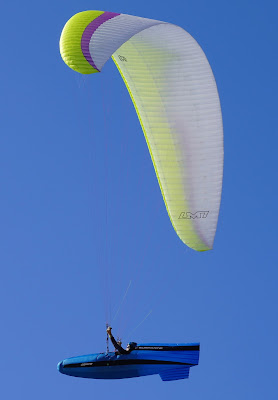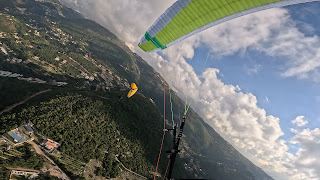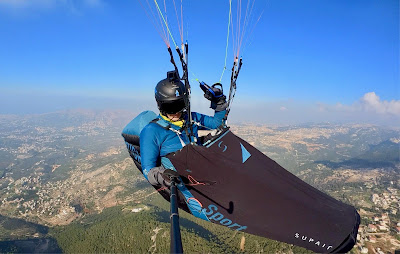NIVIUK Artik-R size 23
If you already read my previous test about the Artik 6 , then you surely felt that I really appreciated that overall complete glider. Now as the C certification allowed the use of collapse lines and other changes, Niviuk released to the market their new C class model, with its 2-line version and with a 6.5 aspect ratio.
I have flown the size 23 which is certified from 80-95, and NIVIUK recommends the optimum flying weight of 87-92.
I flew that glider at 88- 92- and 95 all up on my X-rated 6 harness.
The Artik-R has a really nice construction and the finishing details are really impressive. I think NIVIUK has made it a step further in delivering a really neat high quality product which is clearly shown when you unbox it.
Launching :
Pulling on the A’s on the Artik-R at 92 all up, gave me a little heavy feel at the beginning of the rise, than normal in the middle rise, with very easy take-off behavior even in no wind. The take-off is immediate without the wing surging in front. In a stronger breeze, the Artik -R can be easily mastered by the brakes, and there is no surging forward for a C pilot, rather than an immediate take-off. Overall take-off behavior is quite nice.
Pitch and roll stability:
In the air, and later in different conditions, the pitch felt very stable, getting inside the lift is super comfortable even smoother than the Artik 6 which had a slightly more positive pitch feel. The Artik-R slows very slightly when encountering thermals. The roll stability seems very close to the Artik 6. Overall they felt close in comfort with probably +10…15% pilot demand in turbulent air for the Artik-R. It is not summer yet to be precise, but it feels quite balanced.
The Artik-R has a taught and solid leading edge. Trying to pull the A’s showed me a logical heavy pressure, as the A’s are far back.
Climb rate:
I flew the Artik-R in a very weak lift (+0.3 m/s) with no wind influence, at 93 all up, and I was really efficient with the best C gliders, or even D’s, to confirm after a while that the climb is in weak is really good! The Artik-R could float really well! In stronger thermals or with more wind, the Artik-R behaves calmly in pitch, and needs slightly more time to enter, but with a fairly good climb rate for the category.
Gliding power:
For two days, I had the privilege to fly with my friends on 2-liner C gliders! Yann, on a Volt 4 M size max 102, Elie and I (alternating) Artik-R and LT2.
After many glides, we all had the same conclusions!
The Artik-R holds now the crown having the top glide ratio for the 2 liners by a small margin, especially at full bar which is impressive!
So I decided to try another very good 2-liner EN-D glider. (A Gin Leopard. But a bigger size ‘M’ was only available! ). I know it is not fair to try it with the higher class but just an idea for me and also many pilots suggested that I try…
To be precise, the glide in ‘calm air’ at trim is similar. The glide at bar seems also incredibly similar! The Artik-R showed me a true gliding machine for the C category.
In turbulence and wind, or in the valley breeze, the Leopard with its 7 aspect and thinner profile had the edge of course with a high capacity in getting through and moving forward and up easily which is logical.
I will hopefully try the Leopard with NIVIUK’s new 2-liner EN-D, the ’Peak 6’. A wing of the same class as the Leopard.
Handling and pleasure:
The brake length of the Artik-R is slightly longer than the Artik 6, but it still with good agility. Not as sharp as the A6 in turns, but still good enough to be satisfied. Smoother in turns than the A6, as I was able to core every single thermal easily. The Artik-R doesn’t dive in turns as the A6. It turns more efficiently flat without losing the core.
Throwing wingovers, and playing around on the Artik-R could also be playful, but it was engineered to be an efficient XC tool, getting the most out of the present lift.
Flying the Artik-R in XC and transitions at bar is very efficient for the class. The B controls have a moderate pressure, slightly less than the LT2, with a swift response making it very easy to keep the glider overhead. The leading edge kept its pressure in all my testing, and I was completely satisfied with the complete package.
Ears are stable, and the descent rate with half bar is around -2.5 m/s… -3 m/s, they reopen with pilot intervention. I also flew the Artik-R at 88 all up to be able to comment. It flies and handles a bit slower. It is safely doable if someone wishes., but to be efficiently competitive, I personally prefer to fly the size 23 at +93 all up. I personally like my gliders to feel more dynamic and also I need more connection in strong air.
Flying the Artik-R at 95 won’t lose anything in weak thermals, and would be better in getting faster into the heavy airmass.
360s needs two turns to get smoothly into it. Getting out while keeping your weight shift inside the turn is smooth like any other C.
Conclusion:
Today, manufacturers are trying to satisfy a large group of pilots from the high B's to the high C’s but some are resilient to deliver a suitable and comprehensive 2-liner for the C category. The Artik-R seems to have filled that gap comfortably.
But there’s no miracle! In the 2-liner EN-D category, the Peak 6 for example was created to give you more performance with a higher pilot level.
With the Artik-R, you are flying a 2-liner with near the comfort of 3-liner C’s. Perhaps around a +12 % increase in pilot level in strong air.
There’s no special flying technique for the Artik-R! So a confirmed C pilot, or even a ‘confirmed’ high B pilot with two full seasons in strong air, would find the Artik-R to be a nice evolution to fill his goals.
The overall gliding performance ‘in moving air’ over the 3 liner C’s ‘example Artik 6’ is increased by 10-12 % (just a personal idea)
Now the clearer advantage is the top speed when overlapping pulleys gives around +18 km/h over trim at 1000 ASL.
I’m sure a demo would be an exciting and interesting experience! :-)
















































